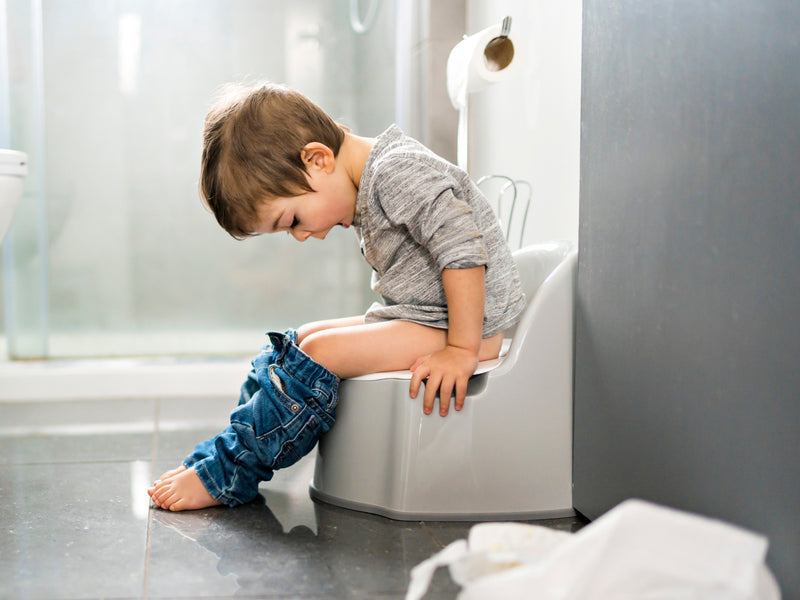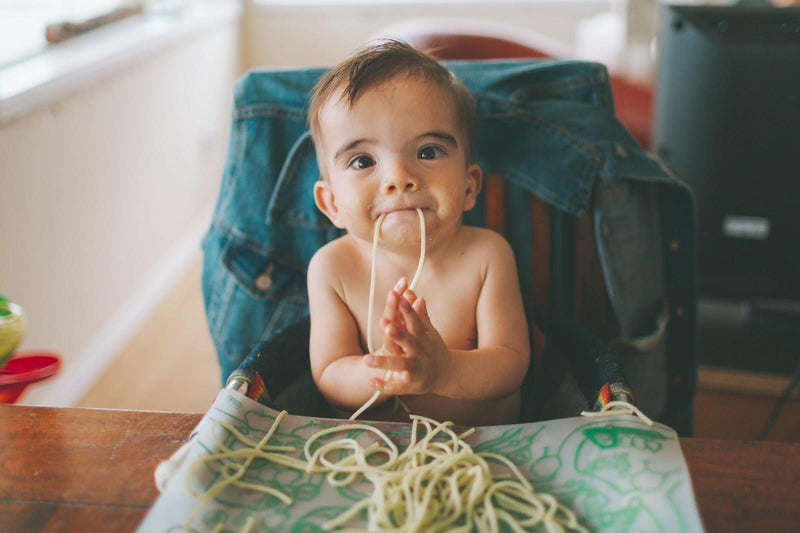
Although most children look forward to being able to use the bathroom on their own, successful potty training can take some time to achieve. The transition between diapers and kid underwear can be difficult and messy for both toddlers and parents. To save you some sweat, here are some pointers to make toddler potty training as smooth as possible for everyone involved.
What is potty training?
Potty training, also known as toilet training, is considered a significant milestone for toddlers because it teaches them to listen to their bodies, and use the bathroom to empty their bladder and intestines. It also implies that you will no longer have to change diapers!
Before you start toilet training with your toddler, be sure they are ready. It will save you and your child a lot of trouble.
How to pick the correct diaper size for your baby
At what age should a child start potty training?
While most children are ready to begin toilet training between 18 months and 3 years old, age is not the only determinant of potty training readiness. Using the potty, like drinking from a cup or using a spoon, is a skill that must be mastered with patience and the force of repetition.
It is most effective when your child's mental and physical development has reached a certain stage. Potty training your child before they are ready can backfire and cause aggravation for everyone involved and can lead to potty training taking longer to complete.
Are pacifiers good for a baby?
Signs that children are ready for potty training
Every child is unique, but here are common signs that children are ready for potty training:
They demonstrate independence
Frequent dry nights
They want to imitate adults
They demonstrate independence
When your toddler says things like "I can do it myself," especially when it comes to potty habits, but also in other areas like feeding and dressing, they are ready to begin toilet training. Your child's independence might also be manifested as a desire to explore new things.
Going to the bathroom is an easy task for most adults, but for toddlers, the numerous procedures needed, such as recognizing the desire to go, turning on the light, pulling down their pants and underwear, sitting on the potty, letting go, wiping, and finally washing their hands can be disorienting.
Remember that potting training is about more than just being willing to follow multi-step instructions; it is also about having the ability to do so, which takes time. Using the toilet, especially to poop, requires some perseverance. Your youngster should be able to be independent enough to sit for several minutes and engage in an activity without becoming distracted or impatient.
Dry nights
When your child is up for two hours or more and/or wakes up with dry diapers, it indicates that their bladder control is developing, which is vital for toilet training. Child development specialist studies demonstrate a substantial link between a child's physical fitness for potty training and their capacity to keep their diaper dry during naps.
They want to imitate adults
To begin, your child must have an interest in learning how to use the potty. They can demonstrate this in a variety of ways:
They are concerned with staying dry or clean.
They are interested in what you do when you go to the bathroom.
They want to be able to wear "big kid" underwear.
You can encourage this interest by reading children's books, viewing potty training videos, and talking about it as you go about your regular parenting daily routine. Modeling healthy toileting habits encourages your child to strive for the same. However, pushing the subject too far may be unproductive, even detrimental.
The 18 months to 3-year readiness range is wide, and where your child falls on the spectrum is determined by several mainly uncontrollable circumstances. Looking for signs of interest will help you determine the optimal moment to begin potty training.
Everything you need to know about washable diapers
How do you know if potty training is working?
Your child may be open to trying new experiences, but that is only a small part of successful potty training. Creating a daily routine around the bathroom will aid in developing patterns of behavior. You’ll know that potty training is working if your child is adopting the bathroom ritual they are shown to follow.
If your child independently follows a certain pattern of behavior when their natural urge arises, your potty training method is off to a great start. For instance, your little one might establish eye contact with you and drop their jaw when they recognize the need to go. Incremental progress with some positive reinforcement is what you should base your approach on.
5 common potty training problems
Here are the 5 most common potty training problems:
Resistance
Accidents
Urges
Insist on diapers
No dry nights
1. Resistance
Resistance may indicate that it is not the appropriate time to begin potty training. If your child has no desire to use the potty, they most likely are not ready. Showing an interest in potty training, hiding during bowel movements, alerting you to soiled diapers, and remaining dry for at least two hours during the day are all common signals of readiness.
2. Accidents
There will be inevitable accidents when beginning potty training. When they happen, be gentle with your child. Punishment and scolding for accidents will create a negative association in your toddler that may prolong potty training, and make them withhold their bodily fluid.
3. Urges
Does your youngster realize the need for a bowel movement but not always the urge to pee? It is natural for those learning to potty train to leak pee. Some children do not have perfect bladder control until they have learned to handle bowel movements. Keep this in mind while you continue your child's potty training.
4. Insist on diapers
This suggests that your child is physiologically, but not emotionally, ready to start using the potty. Instead of viewing this as a failure, commend your child for detecting bowel signals. Suggest that they urinate in the restroom while wearing a diaper.
5. No dry nights
Your toddler, like most toddlers, will probably take a bit longer to finish naptime and overnight toilet training. Encourage your kid to have a potty schedule right before going to bed and right after waking up.
How to get your baby to sleep all night
5 successful potty training tips
These 5 successful potty training tips can assist your child to prevent constipation, bedwetting, and accidents in the future:
Patience
Take it slow
Right equipment
Make it fun
Do not associate potty training with punishment
1. Patience
Wait for your youngster to be ready. Trying to toilet train toddlers who aren’t ready can make the process longer. Avoid commencing training when there are other major changes in your child's life, such as illness, divorce, a death in the family (including a pet), or moving to a new place. There must be a certain daily routine already in place for successful potty training.
2. Take it Slow
Take things slowly at first. Potty training is a procedure that, for most youngsters, consists of several phases that are learned one at a time. Start by leaving a potty seat on the bathroom floor for a few days to get the process started. Tell your youngster that the small toilet is for them and the large one is for adults. Introduce this new concept by creating some curiosity around it.
3. Right equipment
Get the necessary equipment. Child potty seats should be low enough so that both feet are securely planted on the floor. Some seats have numerous stages: they begin as a child-sized seat on the floor and then transform into an adapter that fits on a regular seat.
Equally, to ensure successful potty training, you can get training pants that will allow your toddler to get used to the idea of being wet. However, make sure that you wash these frequently to avoid a urinary tract infection.
4. Make it fun
Make it enjoyable. Boys in the early stages of potty training are infamous for having a poor aim. Adding some o-shaped cereal or other targets to the water, or some blue food coloring (which turns green when the yellow urine hits it), can make urinating more enjoyable for your kid and less messy for you. Boys and girls may enjoy having books to read or a special potty partner (a plush animal or a doll) to keep them company while using the potty.
5. Do not associate potty training with punishment
Punishment should not be a component of potty training. It is impossible to force a child to use the restroom if they are not ready or do not want to. Children who are under stress may try to regain control of the situation by refusing to change their diapers or not going to the bathroom at all. This can result in constipation or other issues that your pediatrician will need to manage.
What to avoid when potty training
While positivity is important, there are some obvious "don'ts" you should avoid. Here are some of the most common well intended, but ultimately ineffective pitfalls to avoid when potty training your child:
Do not force it
Avoid stress
They shouldn’t push hard
Do not force it
Before you begin training, make sure your child is developmentally ready to use the potty. A child's ability to articulate their needs, and the physical agility to handle clothing oneself, are typical markers of preparedness. If you believe your child isn't ready, it's best to wait a few weeks or months before trying again.
If your child refuses to go, forcing them to go and sit on the potty will likely create a negatively charged environment, leading to even more resistance. These bad associations with using the restroom can be difficult to reverse and may cause your child to avoid urinating or voiding, which can be dangerous.
Avoid stress
When it comes to potty training, even good stress is negative stress. Marriages, new infants, holidays, guests, and vacations can be stressful for your child, just as coping with a divorce, death, or a move to a new house can be.
If there is anything huge and new on the horizon in your lives, you should reconsider potty training. It’s best to wait for life to calm down and the normal flow of activity to resume. This provides stability for your child and allows them to easily integrate toileting into their daily routine. Furthermore, you will have more time and positive energy to devote to assisting your child in transitioning out of diapers.
They shouldn’t push hard
When your toddler is seated on their little throne for a number two, you should explain to them that they shouldn’t push too hard, or else they could hurt themselves. By using a toothpaste tube, vulgarize what is happening when bowel movement occurs. In this scenario, the toothpaste is the food they ate not too long ago that now needs to get out. Gently press the tube to show them that stools should come out slow and steady.




